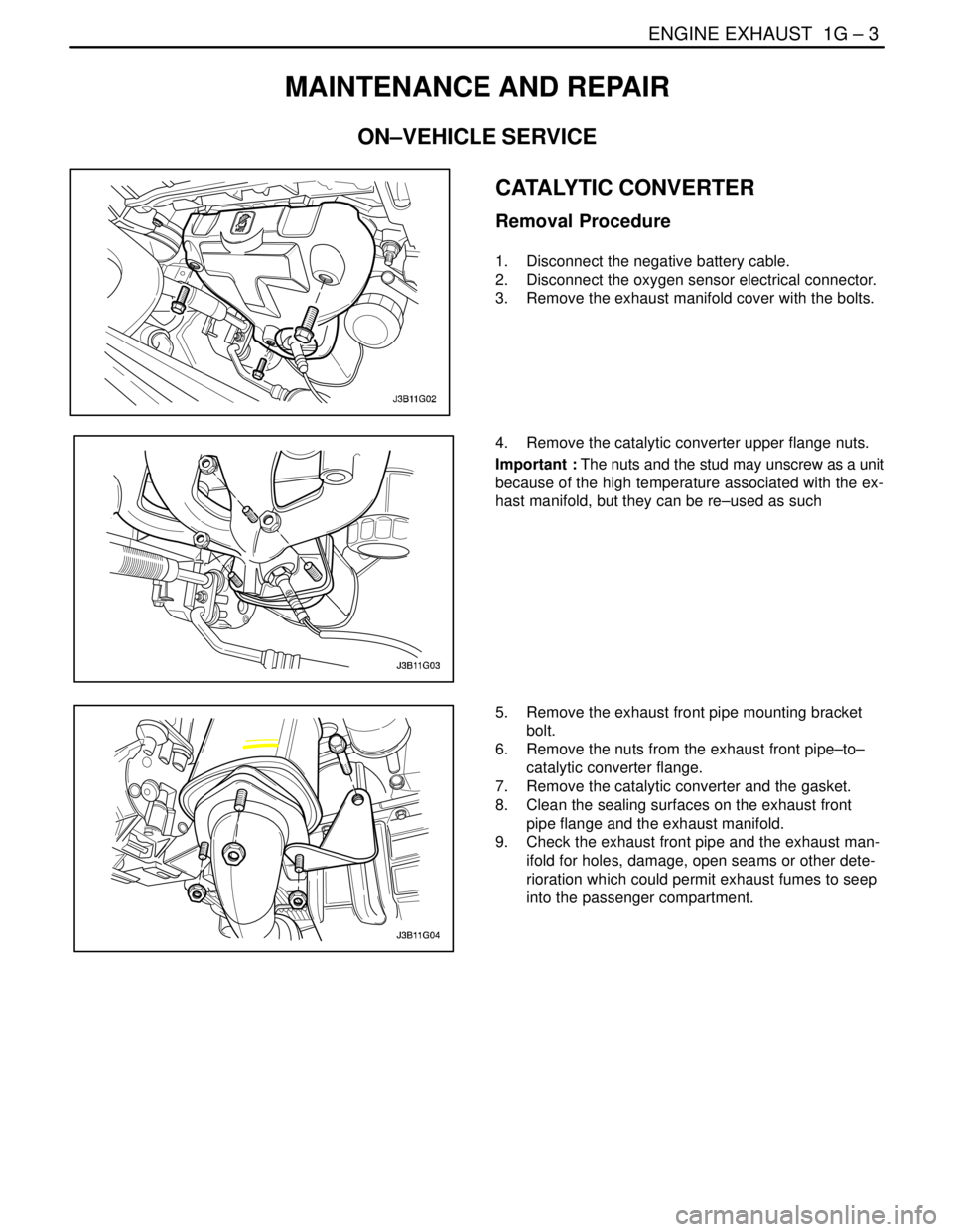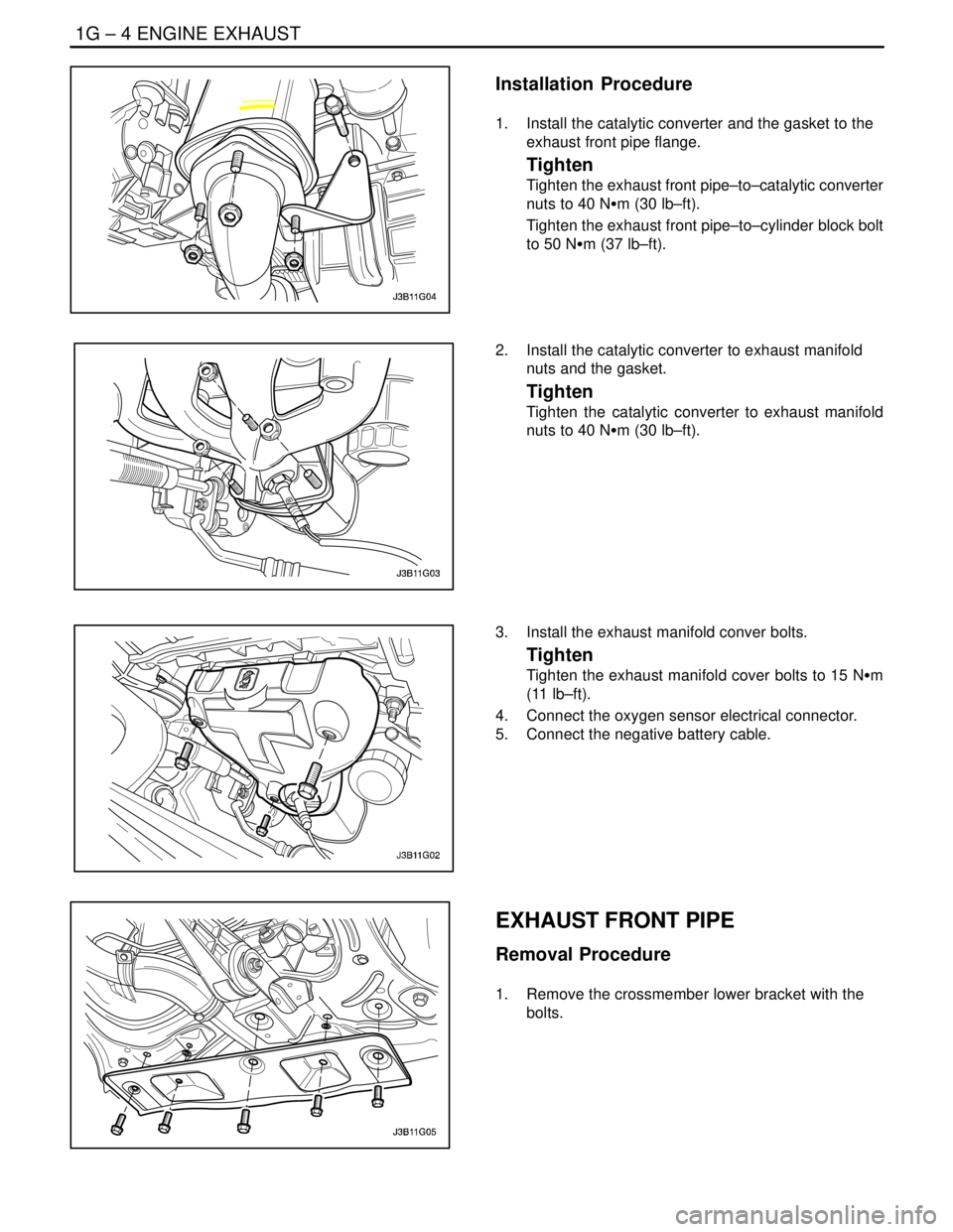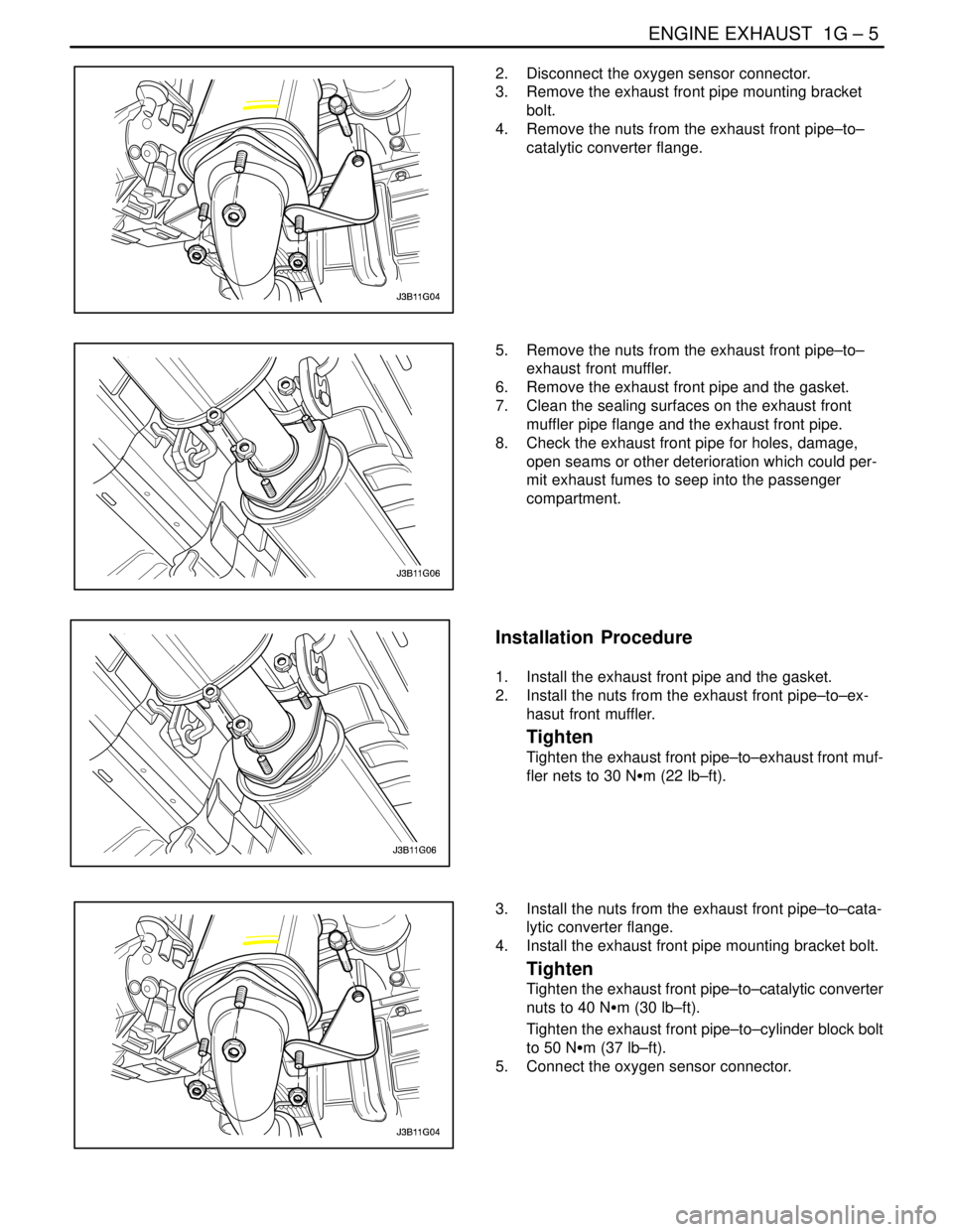2004 DAEWOO LACETTI catalytic converter
[x] Cancel search: catalytic converterPage 869 of 2643

ENGINE CONTROLS 1F – 623
DAEWOO V–121 BL4
GENERAL DESCRIPTION
AND SYSTEM OPERATION
IGNITION SYSTEM OPERATION
This ignition system does not use a conventional distribu-
tor and coil. It uses a crankshaft position sensor input to
the engine control module (ECM). The ECM then deter-
mines Electronic Spark Timing (EST) and triggers the di-
rect ignition system ignition coil.
This type of distributorless ignition system uses a ”waste
spark” method of spark distribution. Each cylinder is
paired with the cylinder that is opposite it (1–4 or 2–3). The
spark occurs simultaneously in the cylinder coming up on
the compression stroke and in the cylinder coming up on
the exhaust stroke. The cylinder on the exhaust stroke re-
quires very little of the available energy to fire the spark
plug. The remaining energy is available to the spark plug
in the cylinder on the compression stroke.
These systems use the EST signal from the ECM to con-
trol the electronic spark timing. The ECM uses the follow-
ing information:
S Engine load (manifold pressure or vacuum).
S Atmospheric (barometric) pressure.
S Engine temperature.
S Intake air temperature.
S Crankshaft position.
S Engine speed (rpm).
ELECTRONIC IGNITION SYSTEM
IGNITION COIL
The Electronic Ignition (EI) system ignition coil provides
the spark for two spark plugs simultaneously. The EI sys-
tem ignition coil is not serviceable and must be replaced
as an assembly.
CRANKSHAFT POSITION SENSOR
This direct ignition system uses a magnetic crankshaft
position sensor. This sensor protrudes through its mount
to within approximately 0.05 inch (1.3 mm) of the crank-
shaft reluctor. The reluctor is a special wheel attached to
the crankshaft or crankshaft pulley with 58 slots machined
into it, 57 of which are equally spaced in 6 degree intervals.
The last slot is wider and serves to generate a ”sync
pulse.” As the crankshaft rotates, the slots in the reluctor
change the magnetic field of the sensor, creating an in-
duced voltage pulse. The longer pulse of the 58th slot
identifies a specific orientation of the crankshaft and al-
lows the engine control module (ECM) to determine the
crankshaft orientation at all times. The ECM uses this in-
formation to generate timed ignition and injection pulses
that it sends to the ignition coils and to the fuel injectors.
CAMAHAFT POSITION SENSOR
The Camshaft Position (CMP) sensor sends a CMP sen-
sor signal to the engine control module (ECM). The ECM
uses this signal as a ”sync pulse” to trigger the injectors in
the proper sequence. The ECM uses the CMP sensor sig-
nal to indicate the position of the #1 piston during its power
stroke. This allows the ECM to calculate true sequential
fuel injection mode of operation. If the ECM detects an in-
correct CMP sensor signal while the engine is running,
DTC P0341 will set. If the CMP sensor signal is lost while
the engine is running, the fuel injection system will shift to
a calculated sequential fuel injection mode based on the
last fuel injection pulse, and the engine will continue to run.
As long as the fault is present, the engine can be restarted.
It will run in the calculated sequential mode with a 1–in–6
chance of the injector sequence being correct.
IDLE AIR SYSTEM OPERATION
The idle air system operation is controlled by the base idle
setting of the throttle body and the Idle Air Control (IAC)
valve.
The engine control module (ECM) uses the IAC valve to
set the idle speed dependent on conditions. The ECM
uses information from various inputs, such as coolant tem-
perature, manifold vacuum, etc., for the effective control
of the idle speed.
FUEL CONTROL SYSTEM
OPERATION
The function of the fuel metering system is to deliver the
correct amount of fuel to the engine under all operating
conditions. The fuel is delivered to the engine by the indi-
vidual fuel injectors mounted into the intake manifold near
each cylinder.
The two main fuel control sensors are the Manifold Abso-
lute Pressure (MAP) sensor, the Front Heated Oxygen
Sensor (HO2S1) and the Rear Heated Oxygen Sensor
(HO2S2).
The MAP sensor measures or senses the intake manifold
vacuum. Under high fuel demands the MAP sensor reads
a low vacuum condition, such as wide open throttle. The
engine control module (ECM) uses this information to ri-
chen the mixture, thus increasing the fuel injector on–time,
to provide the correct amount of fuel. When decelerating,
the vacuum increases. This vacuum change is sensed by
the MAP sensor and read by the ECM, which then de-
creases the fuel injector on–time due to the low fuel de-
mand conditions.
HO2S Sensors
The HO2S sensor is located in the exhaust manifold. The
HO2S sensor indicates to the ECM the amount of oxygen
in the exhaust gas and the ECM changes the air/fuel ratio
to the engine by controlling the fuel injectors. The best air/
fuel ratio to minimize exhaust emissions is 14.7 to 1, which
allows the catalytic converter to operate most efficiently.
Page 871 of 2643

ENGINE CONTROLS 1F – 625
DAEWOO V–121 BL4
EVAPORATIVE EMISSION CANISTER
The Evaporative (EVAP) Emission canister is an emission
control device containing activated charcoal granules.
The EVAP emission canister is used to store fuel vapors
from the fuel tank. Once certain conditions are met, the en-
gine control module (ECM) activates the EVAP canister
purge solenoid, allowing the fuel vapors to be drawn into
the engine cylinders and burned.
POSITIVE CRANKCASE
VENTILATION SYSTEM OPERATION
A Positive Crankcase Ventilation (PCV) system is used to
provide complete use of the crankcase vapors. Fresh air
from the air cleaner is supplied to the crankcase. The fresh
air is mixed with blowby gases which are then passed
through a vacuum hose into the intake manifold.
Periodically inspect the hoses and the clamps. Replace
any crankcase ventilation components as required.
A restricted or plugged PCV hose may cause the following
conditions:
S Rough idle
S Stalling or low idle speed
S Oil leaks
S Oil in the air cleaner
S Sludge in the engine
A leaking PCV hose may cause the following conditions:
S Rough idle
S Stalling
S High idle speed
ENGINE COOLANT TEMPERATURE
SENSOR
The Engine Coolant Temperature (ECT) sensor is a
thermistor (a resistor which changes value based on tem-
perature) mounted in the engine coolant stream. Low cool-
ant temperature produces a high resistance (100,000
ohms at –40 °F [–40 °C]) while high temperature causes
low resistance (70 ohms at 266 °F [130 °C]).
The engine control module (ECM) supplies 5 volts to the
ECT sensor through a resistor in the ECM and measures
the change in voltage. The voltage will be high when the
engine is cold, and low when the engine is hot. By measur-
ing the change in voltage, the ECM can determine the
coolant temperature. The engine coolant temperature af-
fects most of the systems that the ECM controls. A failure
in the ECT sensor circuit should set a diagnostic trouble
code P0117 or P0118. Remember, these diagnostic
trouble codes indicate a failure in the ECT sensor circuit,
so proper use of the chart will lead either to repairing a wir-
ing problem or to replacing the sensor to repair a problem
properly.
THROTTLE POSITION SENSOR
The Throttle Position (TP) sensor is a potentiometer con-
nected to the throttle shaft of the throttle body. The TP sen-
sor electrical circuit consists of a 5 volt supply line and a
ground line, both provided by the engine control module
(ECM). The ECM calculates the throttle position by moni-
toring the voltage on this signal line. The TP sensor output
changes as the accelerator pedal is moved, changing the
throttle valve angle. At a closed throttle position, the output
of the TP sensor is low, about 0.5 volt. As the throttle valve
opens, the output increases so that, at Wide Open Throttle
(WOT), the output voltage will be about 5 volts.
The ECM can determine fuel delivery based on throttle
valve angle (driver demand). A broken or loose TP sensor
can cause intermittent bursts of fuel from the injector and
an unstable idle, because the ECM thinks the throttle is
moving. A problem in any of the TP sensor circuits should
set a diagnostic trouble code (DTC) P0121 or P0122.
Once the DTC is set, the ECM will substitute a default val-
ue for the TP sensor and some vehicle performance will
return. A DTC P0121 will cause a high idle speed.
CATALYST MONITOR OXYGEN
SENSORS
Three–way catalytic converters are used to control emis-
sions of hydrocarbons (HC), carbon monoxide (CO), and
oxides of nitrogen (NOx). The catalyst within the convert-
ers promotes a chemical reaction. This reaction oxidizes
the HC and CO present in the exhaust gas and converts
them into harmless water vapor and carbon dioxide. The
catalyst also reduces NOx by converting it to nitrogen. The
engine control module (ECM) can monitor this process us-
ing the HO2S1 and HO2S2 sensor. These sensors pro-
duce an output signal which indicates the amount of oxy-
gen present in the exhaust gas entering and leaving the
three–way converter. This indicates the catalyst’s ability to
efficiently convert exhaust gasses. If the catalyst is operat-
ing efficiently, the HO2S1 sensor signals will be more ac-
tive than the signals produced by the HO2S2 sensor. The
catalyst monitor sensors operate the same way as the fuel
control sensors. The sensor’s main function is catalyst
monitoring, but they also have a limited role in fuel control.
If a sensor output indicates a voltage either above or below
the 450 mv bias voltage for an extended period of time, the
ECM will make a slight adjustment to fuel trim to ensure
that fuel delivery is correct for catalyst monitoring.
A problem with the HO2S1 sensor circuit will set DTC
P0131, P0132, P0133 or P0134 depending, on the special
condition. A problem with the HO2S2 sensor signal will set
DTC P0137, P0138, P0140 or P0141, depending on the
special condition.
A fault in the Rear Heated Oxygen Sensor (HO2S2) heat-
er element or its ignition feed or ground will result in lower
oxygen sensor response. This may cause incorrect cata-
lyst monitor diagnostic results.
Page 881 of 2643

SECTION : 1G
ENGINE EXHAUST
TABLE OF CONTENTS
SPECIFICATIONS1G–1 . . . . . . . . . . . . . . . . . . . . . . . . . .
Fastener Tightening Specifications 1G–1. . . . . . . . . .
COMPONENT LOCATOR1G–2 . . . . . . . . . . . . . . . . . . . .
Exhaust System 1G–2. . . . . . . . . . . . . . . . . . . . . . . . . .
MAINTENANCE AND REPAIR1G–3 . . . . . . . . . . . . . . .
ON–VEHICLE SERVICE 1G–3. . . . . . . . . . . . . . . . . . . . .
Catalytic Converter 1G–3. . . . . . . . . . . . . . . . . . . . . . . . Exhaust Front Pipe 1G–4. . . . . . . . . . . . . . . . . . . . . . . .
Muffler – Front 1G–6. . . . . . . . . . . . . . . . . . . . . . . . . . . .
Muffler – Rear 1G–7. . . . . . . . . . . . . . . . . . . . . . . . . . . .
GENERAL DESCRIPTION AND SYSTEM
OPERATION1G–9 . . . . . . . . . . . . . . . . . . . . . . . . . . . . . .
Exhaust System 1G–9. . . . . . . . . . . . . . . . . . . . . . . . . .
Muffler 1G–9. . . . . . . . . . . . . . . . . . . . . . . . . . . . . . . . . . .
Catalytic Converters 1G–9. . . . . . . . . . . . . . . . . . . . . . .
SPECIFICATIONS
FASTENER TIGHTENING SPECIFICATIONS
ApplicationNSmLb–FtLb–In
Catalytic Converter–to–Exhaust Manifold Nuts4037–
Exhaust Front Pipe–to–Catalytic Converter Nuts4030–
Exhaust Manifold Cover Bolts1511–
Exhaust Front Pip–to–Front Muffler3022–
Front Muffler–to–Rear Muffler Nuts3022–
Front Bracket–to–Cylinder Block Bolt5037–
Catalytic Converter–to–Underbody Shield2.5–22
Front Muffler–to–Underbody Shield2.5–22
Rear Muffler–to–Underbody Shield2.5–22
Page 882 of 2643

1G – 2IENGINE EXHAUST
DAEWOO V–121 BL4
COMPONENT LOCATOR
EXHAUST SYSTEM
1. Exhaust Rear Muffler
2. Muffler Gasket
3. Exhaust Front Muffler
4. Muffler Gasket
5. Exhaust Front Pipe (1.8D)
6. Exhaust Front Pipe (1.6D)
7. Catalytic Converter8. Exhaust Pipe Front Gasket
9. Exhaust Front Pipe Gasket
10. Exhaust Manifold
11. Catalytic Converter Protective Shield
12. Front Muffler Protective Shield
13. Rear Muffler Protective Shield
Page 883 of 2643

ENGINE EXHAUST 1G – 3
DAEWOO V–121 BL4
MAINTENANCE AND REPAIR
ON–VEHICLE SERVICE
CATALYTIC CONVERTER
Removal Procedure
1. Disconnect the negative battery cable.
2. Disconnect the oxygen sensor electrical connector.
3. Remove the exhaust manifold cover with the bolts.
4. Remove the catalytic converter upper flange nuts.
Important : The nuts and the stud may unscrew as a unit
because of the high temperature associated with the ex-
hast manifold, but they can be re–used as such
5. Remove the exhaust front pipe mounting bracket
bolt.
6. Remove the nuts from the exhaust front pipe–to–
catalytic converter flange.
7. Remove the catalytic converter and the gasket.
8. Clean the sealing surfaces on the exhaust front
pipe flange and the exhaust manifold.
9. Check the exhaust front pipe and the exhaust man-
ifold for holes, damage, open seams or other dete-
rioration which could permit exhaust fumes to seep
into the passenger compartment.
Page 884 of 2643

1G – 4IENGINE EXHAUST
DAEWOO V–121 BL4
Installation Procedure
1. Install the catalytic converter and the gasket to the
exhaust front pipe flange.
Tighten
Tighten the exhaust front pipe–to–catalytic converter
nuts to 40 NSm (30 lb–ft).
Tighten the exhaust front pipe–to–cylinder block bolt
to 50 NSm (37 lb–ft).
2. Install the catalytic converter to exhaust manifold
nuts and the gasket.
Tighten
Tighten the catalytic converter to exhaust manifold
nuts to 40 NSm (30 lb–ft).
3. Install the exhaust manifold conver bolts.
Tighten
Tighten the exhaust manifold cover bolts to 15 NSm
(11 lb–ft).
4. Connect the oxygen sensor electrical connector.
5. Connect the negative battery cable.
EXHAUST FRONT PIPE
Removal Procedure
1. Remove the crossmember lower bracket with the
bolts.
Page 885 of 2643

ENGINE EXHAUST 1G – 5
DAEWOO V–121 BL4
2. Disconnect the oxygen sensor connector.
3. Remove the exhaust front pipe mounting bracket
bolt.
4. Remove the nuts from the exhaust front pipe–to–
catalytic converter flange.
5. Remove the nuts from the exhaust front pipe–to–
exhaust front muffler.
6. Remove the exhaust front pipe and the gasket.
7. Clean the sealing surfaces on the exhaust front
muffler pipe flange and the exhaust front pipe.
8. Check the exhaust front pipe for holes, damage,
open seams or other deterioration which could per-
mit exhaust fumes to seep into the passenger
compartment.
Installation Procedure
1. Install the exhaust front pipe and the gasket.
2. Install the nuts from the exhaust front pipe–to–ex-
hasut front muffler.
Tighten
Tighten the exhaust front pipe–to–exhaust front muf-
fler nets to 30 NSm (22 lb–ft).
3. Install the nuts from the exhaust front pipe–to–cata-
lytic converter flange.
4. Install the exhaust front pipe mounting bracket bolt.
Tighten
Tighten the exhaust front pipe–to–catalytic converter
nuts to 40 NSm (30 lb–ft).
Tighten the exhaust front pipe–to–cylinder block bolt
to 50 NSm (37 lb–ft).
5. Connect the oxygen sensor connector.
Page 889 of 2643

ENGINE EXHAUST 1G – 9
DAEWOO V–121 BL4
GENERAL DESCRIPTION
AND SYSTEM OPERATION
EXHAUST SYSTEM
Notice : When you are inspecting or replacing the exhaust
system components, make sure there is adequate clear-
ance from all points on the underbody to avoid possible
overheating of the floor pan and possible damage to the
passenger compartment insulation and trim materials.
CAUTION : Check the complete exhaust system and
the nearby body areas and the trunk lid for broken,
damaged, missing, or mispositioned parts, open
seams, holes, loose connections, or other deteriora-
tion which could permit hazardous exhaust fumes to
seep into the trunk or the passenger compartment.
Dust or water in the trunk may be an indication of a
problem in one of these areas. Any defects should be
corrected immediately.
MUFFLER
If holes, open seams or any deterioration is discovered
upon inspection of the front muffler and pipe assembly, the
complete assembly should be replaced. The same proce-
dure is applicable to the rear muffler assembly.
Heat shields in the front and the rear muffler assembly
positions, as well as for the catalytic converter and the
connecting pipe, protect the vehicle and the environment
from high temperatures the exhaust system develops.
CATALYTIC CONVERTERS
Notice : The catalytic converter requires the use of un-
leaded fuel only, or damage to the catalyst will result.
The catalytic converters are emission control devices add-
ed to the exhaust system to reduce pollutants from the ex-
haust pipes.
The three–way catalyst has coatings which contain palla-
dium, platinum and rhodium, which simultaneouly lower
the levels of HC, CO and NOx.